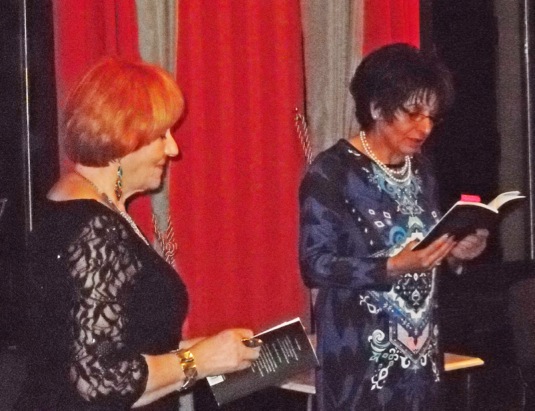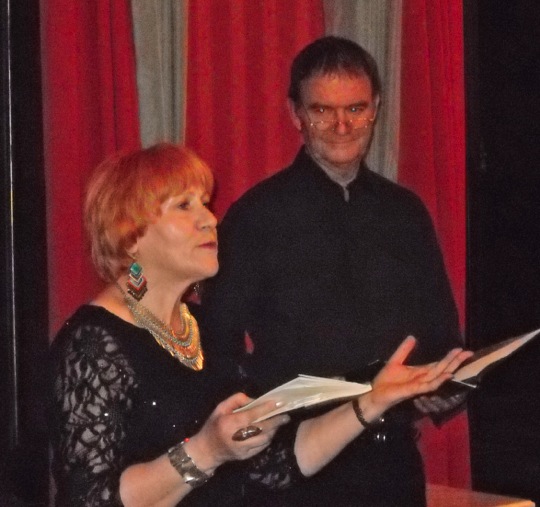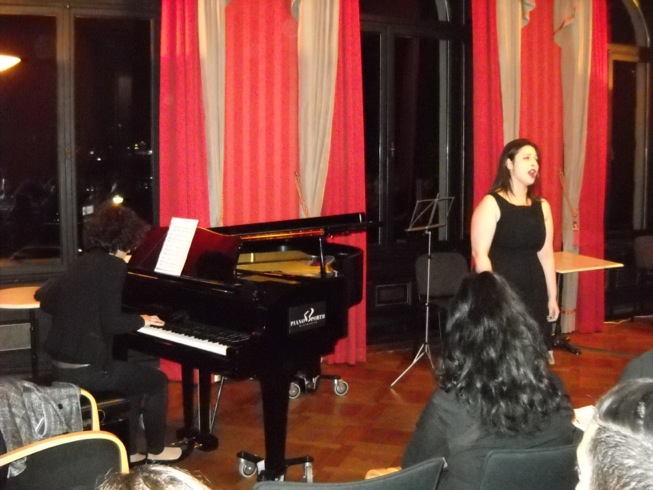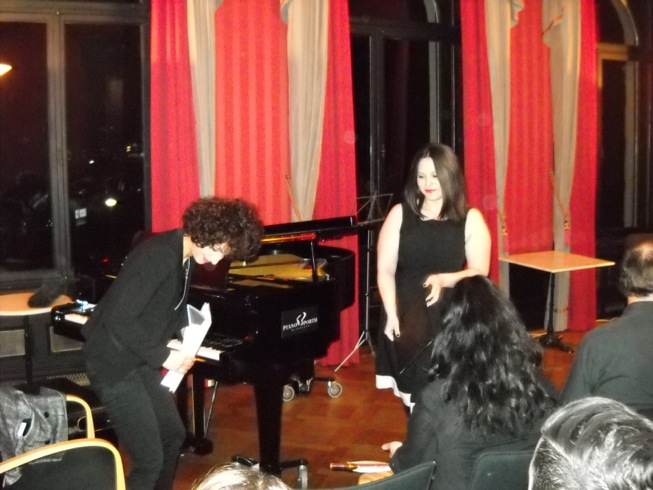Germans Celebrate Paruyr Sevak
Special to the Mirror-Spectator – DECEMBER 3, 2015
By Muriel Mirak-Weissbach
WIESBADEN, Germany — The saying goes that “there is no more beautiful woman than the Armenian language.” If that is the case, German author Jochen Mangelsen writes, then the two women who have just published a new German translation of poems by Paruyr Sevak “have tackled a really audacious task.” It is an adventure, he goes on, not only for the translators but for the reader who encounters this language “full of secrets, surrealistic images, dreams and dreamlike playfulness.” Mandelsen, who has published on the Armenian Genocide, made these remarks in his introduction, or rather, “greetings,” to the new book.

Lisa Berkian-Abrahamian and Agapi Mkrtchian
Indeed the slim volume, Paruyr Sevak: And It Pierces My Soul: 24 and 4 Poems Armenian-German published by Schiler Verlag in Berlin, is a huge achievement. The sub-title symbolically recalls the tragic date of 24.4, or April 24, 1915, when the leading members of the intelligentsia were rounded up in Constantinople, arrested and almost all put to death. Heide Rieck, a prize-winning German author of 12 books, including drama, poetry, prose and essays, worked on this project for two years together with Agapi Mkrtchian, an Armenian author of numerous volumes of short stories and poems, in both German and Armenian. Mkrtchian, who studied in Yerevan, Jena and Frankfurt and teaches German literature in Wiesbaden, was recently honored in Yerevan by the Armenian Writers Union with the Vasdakovor order, as an author of outstanding merit. The book concludes with two appreciations from Armenian scholars, literary critic Ani Pashyan, and Prof. Samuel Muardyan, from the Yerevan State University Chair for Armenian Literature. Lisa Berkian-Abrahamian and Hartmut Borchers
Lisa Berkian-Abrahamian and Hartmut Borchers
The translators have succeeded in producing a work that is rigorously faithful to the original, in content and rhythm, yet at the same time poetically effective in German. This was demonstrated with great power during a musical reading of selections on November 20 at the Literaturhaus in Wiesbaden, Germany. The event at this meeting place for writers, housed in the beautiful, historic Villa Clementine, was a benefit evening sponsored by the Mirak-Weissbach Foundation, which supports Armenian youth in education, including musical education. The participants who recited poems donated their talents to the cause, and Dinges & Frick printers produced beautiful posters and flyers as their contribution.
Although unfortunately illness prevented co-author Heide Rieck from attending, Agapi Mkrtchian presented the book project and gave an overview of Sevak’s life and work. She stressed the fact that Sevak was not only a poet, but also a literary scholar and translator. Although he is the most beloved poet for Armenians, young and old, he is unfortunately not very well know abroad. It is in an attempt to make his art and ideas available to a German public that this new translation has come into being.
Tigranuhi Howhannisyan, a young Yerevan-born singer who has completed her studies in Frankfurt, opened the presentations with a song by Komitas, a composer whose life played an important part in Sevak’s work. Other pieces performed were compositions by Romanos Melikyan and Melik Mavisakalyan. Accompanying her on the piano was Diana Sahakyan, a prize-winning musician, also from Armenia and working in the Frankfurt area. Further musical offerings by Komitas, Ruben Hakhverdyan and Aram Khachaturyan came from the very young Arpi Nazaryan, who has won prizes as a soloist on the transverse flute.
Lisa Berkian-Abrahamian recited in Armenian, her mother tongue. Berkian-Abrahamian is also the author of a book on her late husband, Ara Berkian, who was an architect, sculptor, painter and philanthropist. She wrote her thesis on Sevak, her favorite poet, a fact which helps explain the particular power of her delivery. Presenting the German translations were three members of a poetry-lovers society, the Dichterpflänzchen (which has been performing in the region for over 20 years), Hartmut Borchers, Gabriele Liebig and Lutz Schauerhammer.
Sometimes the poem was recited first in German, then in Armenian; and sometimes, the Armenian came first. This way, bilingual Armenians in the audience (who probably were the majority) could appreciate the quality of the German version, while the Germans could develop an ear for the rich sounds of the Armenian. Among the poems selected, some developed philosophical themes, like “The One-eyed” and “Sand a Leopard”, others treated human relations and love, like “One of us.” Still others pondered the meaning of life and death, as in “One Meets in Life by Chance” and “Dying (or: To Die).” A good example of the poet’s sense of irony came in “I Am Going Crazy.” Several dealt with the homeland and the fate of Armenians, a dominant theme in Sevak’s works, for example, “The Mother’s Hands,” and, as a triumphant finale, “We Are Few, But We Are Called Armenians.” The recitation of this last beloved poem, both in the original and in translation, moved many to tears. Its final line (in English translation) is: “We are. We shall be, and we shall become even more.” Arpi Nazaryan’s concluding flute solo sang a lyrical reflection on this proud, yet modest assertion of Armenian identity.

 – Soprano Tigranuhi Howhannisyan performing with Diana Sahakyan
– Soprano Tigranuhi Howhannisyan performing with Diana Sahakyan

